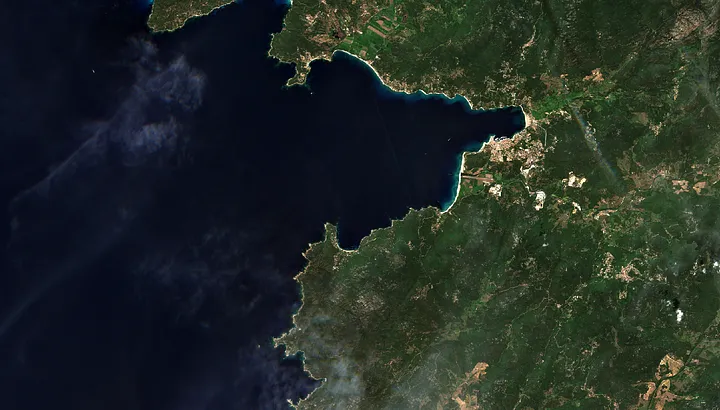Quantum Computing on Arduino

Satellite imagery has been a game-changer in many fields, from meteorology and environmental sciences to city planning and real estate. The ability to look at our planet from above offers insights that ground-based observation cannot provide. However, accessibility to such high-resolution imagery has often been perceived as costly and complicated. It doesn’t have to be! The European Space Agency (ESA) has a wealth of satellite imagery that is not just high resolution (up to 10 meters) but also free to access, download, and use. This resource is provided through their Earth Observation Program, with the Copernicus mission at its heart. Imagine the potential of this! Whether you’re an environmental researcher looking to analyze deforestation, an urban planner in need of accurate city topography, or a tech enthusiast eager to experiment with satellite imagery data, you now have a powerful tool at your fingertips.
To get started, you first need to sign up on Copernicus Scihub. This is ESA’s gateway for satellite data distribution, offering petabytes of information just a few clicks away. The sign-up process is straightforward: go to the Copernicus Open Access Hub, click on the sign-up button, and fill in the required details. Make sure to remember your username and password because you will need them in the next steps.
Now, let’s get to the exciting part. First install sentinelsat with the following command:
pip install sentinelsat
Now with just 4 lines of Python code, you can access this treasure trove of satellite data. Here’s the basic script:
import fnmatch
from sentinelsat import SentinelAPI, make_path_filter
sapi = SentinelAPI('user', 'password', 'https://scihub.copernicus.eu/dhus/')
products = sapi.query(date=('NOW-1DAYS', 'NOW'), platformname='Sentinel-2', processinglevel='Level-2A')
sapi.download_all(products, './tempdataset', nodefilter=lambda a: fnmatch.fnmatch(a['node_path'], '*_TCI_10m.jp2'))
In these four lines of code:
The beauty of this approach is its flexibility. You can adjust the query parameters based on your specific needs, like the date range, the satellite platform, or the acceptable cloud cover percentage. It’s that simple! Now, you can start exploring, analyzing, and using high-resolution satellite imagery, free of charge, and with just a few lines of code. The sky is not the limit; it’s the starting point!
Article on medium.
During my Quantum Computing journey, I often needed to simulate some quantum circuits; sometimes they are small, but some other times they are bigger enough ...
Despite it is sold as a non-cartographic handled GPS device, with limited storage capacity of 10 MB and the inability to expand it, the eTrex 10 GPS, like al...
Since the latest v0.1.18 version, the Qlasskit library offers two useful tool for circuit analysis and optimization.
In the last release of Qlasskit, I introduced a new feature able to export a qlassf function to a binary quadratic model (as bqm, qubo or ising model). This...
In early 2023, I embarked on a journey to explore the field of probabilistic computing. This endeavor culminated in the construction of a hardware prototype,...
Today, I’m going to show you how to use Qlasskit to create a quantum circuit able to search for Sudoku puzzle solutions.
In a recent article I wrote, “Quantum Computing on a Commodore 64 in 200 Lines of BASIC”, published both on Medium and Hackaday.com, shows a two-qubit quantu...
Traditionally, creating quantum circuits requires specialized knowledge in quantum programming. This requirement holds true when encoding a classical algorit...
In an age where companies are selling two-qubit quantum computers for a sum of money that would make your wallet recoil in horror, here we are, stepping off ...
This June I emerged as one of the top participants with 9 bounties collected (alongside another exceptional contributor) in the #UnitaryHack Hackathon, hoste...
A few days ago I came across a yt video discussing the ESA Copernicus program, a European initiative for monitoring earth via a satellite constellation. This...
Qiskit is a python SDK developed by IBM and allows everyone to create quantum circuits, simulate them locally and also run the quantum circuit on a real quan...
As someone noticed from the previous post, last weeks I started to write a new programming language for Tezos smart contracts. This project was initially int...
While writing a new programming language, it is often useful to write some real use-cases to test the syntax, the language expressiveness and the code cleann...
Documentation is like sex: when it is good, it is very, very good; and when it is bad, it is better than nothing
This is my new blog, based on jekyll. I’ll soon import old posts from my old blog.
Contractvm is a general-purpose decentralized framework based on blockchain. The framework allows to implement arbitrary decentralized applications in an eas...
Most of bitcoin dice software use a system to prove the fair play of the server for each bet. Most of them implement this mechanism using two seed (server se...
In the aim to merge two of my server on digitalocean, today I tried to write a mod_rewrite rule to redirect a secondary domain to a subfolder. After one hour...
MineML is a multithread CPU based bitcoin miner written in F#. At the moment it’s a slow implementation, but the class structure offers the possibility to im...